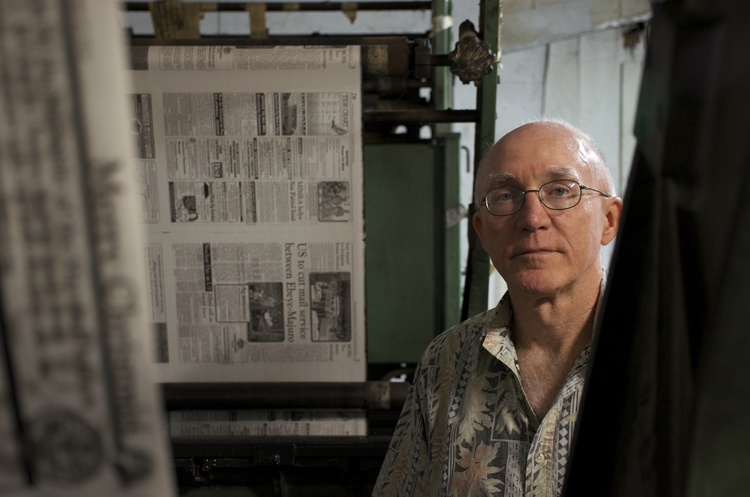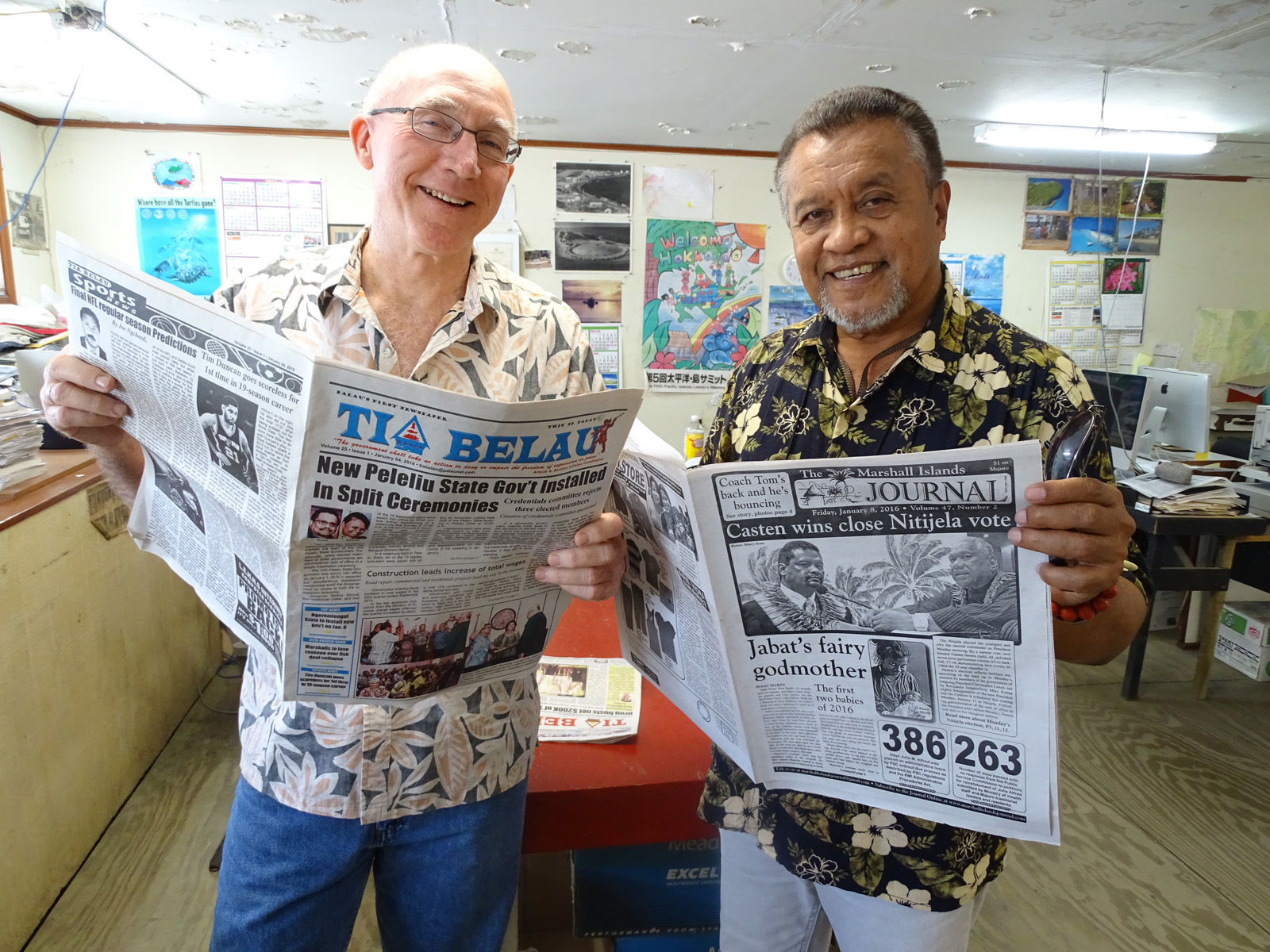Sign up for The Media Today, CJR’s daily newsletter.
Putting out a national newspaper is tough in any corner of the world. But being a newspaperman in one of the world’s most isolated nations offers unique challenges.
“We’ve got a 60-year-old [printing] press and, believe me, you can’t walk down to the corner hardware store to get a replacement part when you’re in the Marshall Islands,” says Giff Johnson, editor in chief of The Marshall Islands Journal, from his home in the capital of Majuro last month.
“In terms of paper, from the time you put an order in, it’ll probably take six months to get the container in. You have to know how much you’re using,” he adds.
The Journal is the only newspaper in this tiny country of around 50,000 people, spread across 29 coral atolls in the South Pacific. Launched in 1970 by Joe Murphy, an Irish Catholic journalist and Peace Corps volunteer from Philadelphia, the small but hard-hitting weekly publication has become a mainstay of the media landscape in this sparse region.
Back then, the publication was called the Micronitor and, despite a slow start, its critical coverage of the US Trust Territory administration that controlled the islands soon curried favor with the locals.
“The publication enraged and enraptured news-hungry bureaucrats and politicians alike, plunging recklessly in vituperation against the colonialist Americans, self-serving politicos in the Congress of Micronesia, and soft-butted scions of the lackluster Trust Territory administration,” Murphy wrote in the Journal’s 35th anniversary issue in 2004.
Born in Chicago in 1956, Johnson moved to Hawaii with his family when he was 10. It was here, and later in Fiji, that he became involved in advocacy work, with particular interest in the nuclear fallout from tests conducted by the French in Polynesia during the 1960s and 1970s. After meeting his first wife, Darlene Keju, a Marshallese national studying in Hawaii, in 1984 the pair relocated to her homeland. Murphy offered Johnson a reporting job at the Journal.
“I just said: ‘Well, I didn’t come here to work on the paper, I just followed my wife,’” Johnson laughs. “She had a job in the Ministry of Health and I was just looking around and he said, ‘Sure, why don’t you come and be a reporter?’”
Within four months, he had taken over as editor in chief—a role he’s held ever since.

Giff Johnson in the Journal’s pressroom. Photo: Dan Zak.
Despite printing just a couple thousand copies a week, the Journal has earned a reputation for punching above its weight, reporting extensively on the issues affecting the Marshallese people. And few topics have filled column inches like the US’s catastrophic foreign policy on the islands.
From 1946 to 1958, the US conducted 67 nuclear missile tests in the Marshall Islands. The most notorious, “Castle Bravo,” detonated in Bikini Atoll in 1954, was roughly 1,000 times more powerful than each of the atomic bombs dropped on Hiroshima and Nagasaki during World War II. All combined, the tests worked out to the equivalent of dropping 1.6 Hiroshima bombs every day for 12 years.
“That was the Chernobyl of the Marshall Islands back in 1954, except in 1986, when Chernobyl happened. We had CNN on the spot, so we could all watch the glorious detail of a nuclear plant melting down and irradiating a continent,” Johnson says. “But the Marshall Islands’ ‘Bravo’ test was worse. Still today it has all kinds of health ramifications for Marshall Islanders.”
Sixty years after the last nuclear weapons test was conducted in the Marshall Islands, its legacy continues to reverberate in the form of health problems and people living in exile due to the radioactive contamination of their home islands.
The knock-on effects of the tests—which have amounted to a kind of nuclear colonialism for the islands—have been devastating, with more than half of cancer diagnoses in Rongelap Atoll being attributed to fallout exposure, according to the US National Cancer Institute. Many residents there have accused the US of deliberately using Rongelap islanders as human guinea pigs after they returned home three years after “Castle Bravo.”
The Journal has been a proponent of those voices. A 1995 editorial slammed the “ignominious treatment of the Rongelap Islanders by the US.”
“It would be beneficial if the US government would own up to problems, even if it admits it caused [them] but is doing nothing about remedying,” the Journal wrote.
“Through publication of dozens of articles, many highlighting formerly top-secret nuclear test-era scientific data, the Journal exposed the US government’s cover-up of the Bravo hydrogen bomb fallout in the Marshall Islands,” Johnson says. “These articles have served to inform a couple of generations of Marshall Islanders about the nuclear weapons test legacy—a legacy that was so long shrouded in US government-imposed secrecy that few Marshall Islanders understood the ramifications, even though they may have personally experienced elements of it.”
It has been theJournal’s job to tell these stories, Johnson says. “We were the only people. Who else?”
He points to the July 28, 1995 front page, “US balking at full nuke disclosure,” which slams the “continuing cover up by the United States of vital documents” which was blocking “the true story behind the Bravo test fallout.”
Johnson’s first wife, Darlene, who grew up downwind of the Bikini nuclear tests in Wotje Atoll and went on to become a respected advocate for victims of the fallout, passed away from breast cancer when she was 45. Her father also died of breast cancer, while her mother was diagnosed with it but survived.
“These are the kinds of stories of families out here, people just kind of have multiple cancers in their families affecting so many people, and it’s really hard to pinpoint,” he says. “Nobody could say her cancer was caused by the nuclear testing, but it could have been. She lived in a nuclear testing zone.”
With the world’s major mastheads only dipping in and out of the country “once in a blue moon,” it has been the Journal’s job to tell these stories, Johnson says. “We were the only people. Who else?” he asks.
Meanwhile, the Journal has published countless front-page stories on the Ronald Reagan Ballistic Missile Defense Test Site, better known locally as the Kwajalein Missile Range.
The site is a US missile test facility, but while hundreds of Americans live a life of relative luxury on Kwajalein, around 15,000 Marshallese are crammed onto neighboring Ebeye Island in slumlike conditions, making the mile-long island one of the world’s most overcrowded.
During the 1970s and ’80s, the Journal documented protests by local Marshallese against the test site, which sometimes turned ugly. “The land owners started protesting and they’d sail into these off-limit islands and the lagoon, and that would disrupt the missile testing,” Johnson says.
In “Kabua clubbed on Roi Namur,” an article Johnson freelanced for the Journal from Kwajalein in 1979, he documented a clash between security guards and Marshallese as locals attempted to occupy the island.
And of course, alongside the nuclear fallout, the missile test center, and the weekly grind of crime, politics, and community news, climate change and rising sea levels have increasingly come to the fore for the Journal in the past decade.
“Now you can’t have a paper come out in a week without people talking about climate issues.”
When he moved to the low-lying islands 35 years ago, Johnson says there would be flooding once every few years. But in the past decade, there have been dozens of serious floods causing major damage. If sea levels continue to rise, he expects a possible mass exodus.
“I remember the first story we had on climate was in 1992, because the Marshalls actually hosted a UN-related environment meeting that talked about climate issues. It wasn’t like the way we talk today, but they were broached in terms of ‘this could be a future concern,’” he says. “Now you can’t have a paper come out in a week without people talking about climate issues.”
The Journal is now focusing on Runit Island, in Enewetak atoll, where the US military sealed 80,000 cubic meters of radioactive waste inside a dome in 1977. The dome, which locals aptly refer to as “the tomb,” is already leaking. There are widespread concerns that rising sea levels or a typhoon could flush large amounts of this highly radioactive plutonium into the Pacific Ocean, but the US government claims it has fulfilled its obligations regarding the dome and says it’s now the responsibility of the Marshall Islands government.
Floyd K. Takeuchi, a veteran journalist who grew up in the Marshall Islands and has worked as a reporter and editor on newspapers on Guam, Fiji, and Hawaii, says the Journal has overcome many of the geographic and cultural challenges that come with running a newspaper in the South Pacific.
While technology is easing the difficulties of distributing newspapers in the region, it hasn’t lessened the “tendency in many Pacific Islands cultures to be critical of the news media for ‘airing the dirty laundry in public,’” Takeuchi says.
“In relatively small, consensus-oriented societies, publishing or broadcasting critical reporting is sometimes seen as a threat to the social good,” he says.
While this was true of plenty of places on the planet, Takeuchi says it was magnified on the Marshall Islands due to the fact the capital “could fit into a large American sports stadium with room to spare.”
Johnson remains upbeat about the paper’s future due to improvements in the independence of the judiciary and media since the turn of the century. Last year, Freedom House ranked the Marshall Islands’ media the second-freest in the Pacific, just behind Palau and ahead of Australia and New Zealand.
Last year, Freedom House ranked the Marshall Islands’ media the second-freest in the Pacific.
The business side of things are looking healthy, too, with the paper making a profit. About 20 people are involved in editorial, printing, and distribution. While the majority of the 2,000 papers printed each week stay in Majuro, copies are flown weekly to Kwajalein.
One of two reporters at the Journal, Hilary Hosia grew up on Ebeye and decided he wanted to work for the newspaper five years ago, after traveling to New York and Washington upon winning an essay-writing competition in his junior year. He covers mostly community news and crime.
“I enjoy writing about student accomplishments as much as I love investigating suicide stories,” Hosia writes in an email.
“But I mostly take pride on several reports involving prostitution in the Marshall Islands” he says. “In the five years I’ve spent reporting, I’ve seen and felt positive changes due to stories reported by the Journal, and I strongly feel our leaders are affected by the paper.”
The Journal also has hundreds of online subscribers, with many in high places, including the US State Department, Johnson says.
“That is one of the interesting things about the Journal,” he adds, “that we have a relatively small circulation, but our readership is totally out of proportion…everybody in Washington who deals with the Pacific reads the paper because we’re the only paper here.”
Despite documenting the injustices inflicted by a world superpower, the veteran editor maintains that the Journal will always be a modest, all-hands-on-deck publication. “I empty the garbage, right?” Johnson laughs. “You do what needs to be done. The reporters take their own pictures, I take my own pictures, you just do a little bit of everything.”
Has America ever needed a media defender more than now? Help us by joining CJR today.



